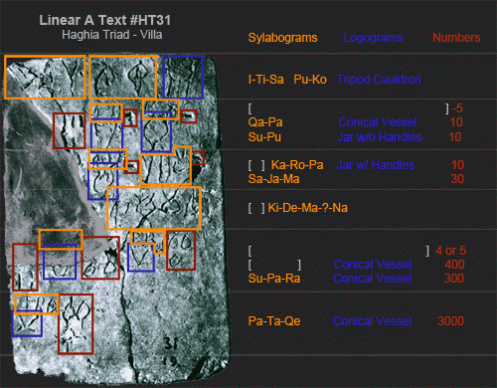Linear A
What do we have?
There are 1427 texts in Louis Godart and Jean-Pierre Olivier’s Recueil des Inscriptions en Linéaire A (1976, 1985) know affectionately by its acronym, GORILA. Documents have been found at 34 sites in Crete, 3 sites in the Cyclades, 2 in Europe and 2 in Asia Minor. The majority of the inscriptions are found on Nodules (c. 900). The most interesting ones are found on clay tablets (c. 250). They also occur with some frequency on Roundels (c. 125) and Direct Object Seals (c. 150). In addition, isolated examples have been found on various gold and silver pins and bronze ingots, six stone libation tables, pots, vessels and mortars, a gold ring, a miniature gold axe and even graffiti.
What do they say?
Most documents are short lists written from left to right. The tablets begin with a short heading, usually two words followed by a sign which is believed to be a transaction abbreviation. There may be subheadings or groups. The lists are often a word of two or three syllabograms associated with a logogram and followed by a number. The most common logograms represent agricultural products (figs, grain, olives and olive oil, wine), livestock (sheep, goats, cattle, pigs), cloth or vessels. I have put together this example for HT31, one of the clay tablets found at the Villa site at Haghia Triad on the south side of Crete.
There are examples of longer non-transaction oriented texts that are believed to be religious inscriptions (e.g., the Libation Formula) but these are rare. There are also “Ledger” tablets that have two lists made up of the same items. These are believed to document contributions and disbursements of commodities.
What are they for?
From the surviving evidence the primary use of Linear A appears to be commercial record keeping. Even the supposedly religious texts do not seem to represent myths or doctrines but rather tabulations of donations, libations and dedications—a religious version of commercial accounting. We have to keep in mind however that these texts are 3500 years old and time provides a highly destructive sorting mechanism. Fired clay nodules and tablets survive for a very long time. There are examples of Linear A on metals, but bronze oxidizes and gold and silver are melted down for reuse so the small number of finds may not reflect actual usage. Wood, textiles, animal hides and papyrus all rapidly decay in the presence of humidity. There is always the possibility that the Minoans used clay for commercial documents and less durable materials for their other non-commercial purposes.


[…] Many of the surviving Linear B tablets are quite similar in their content to Linear A tablets. They are often accounting records of inventories or disbursements and follow the same pattern that […]
Linear B « Several, Four, Many said this on May 18, 2009 at 2:49 am |